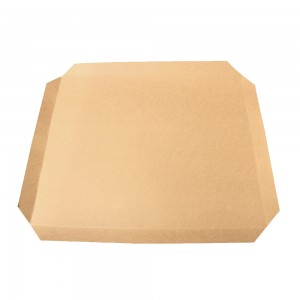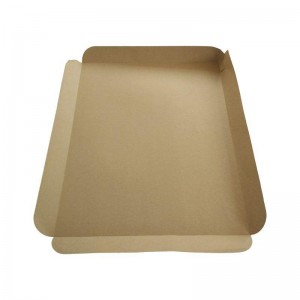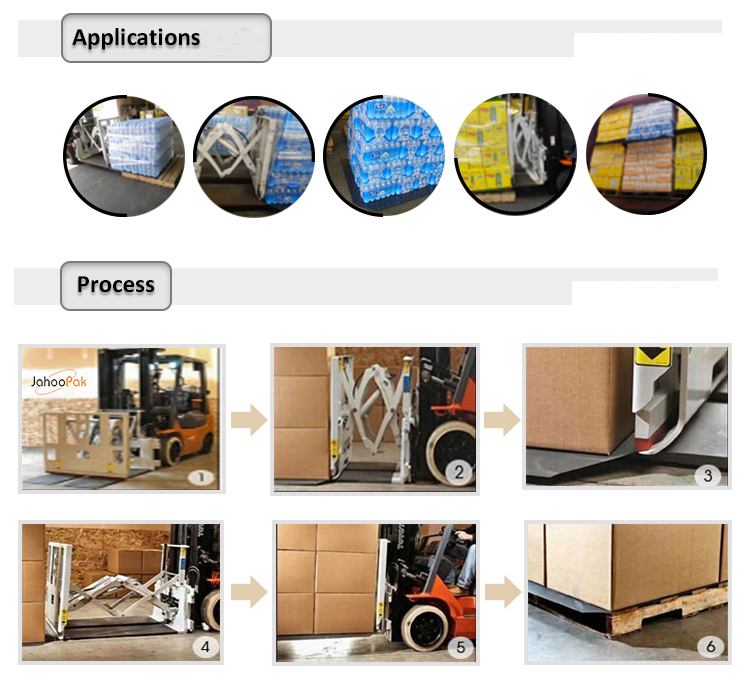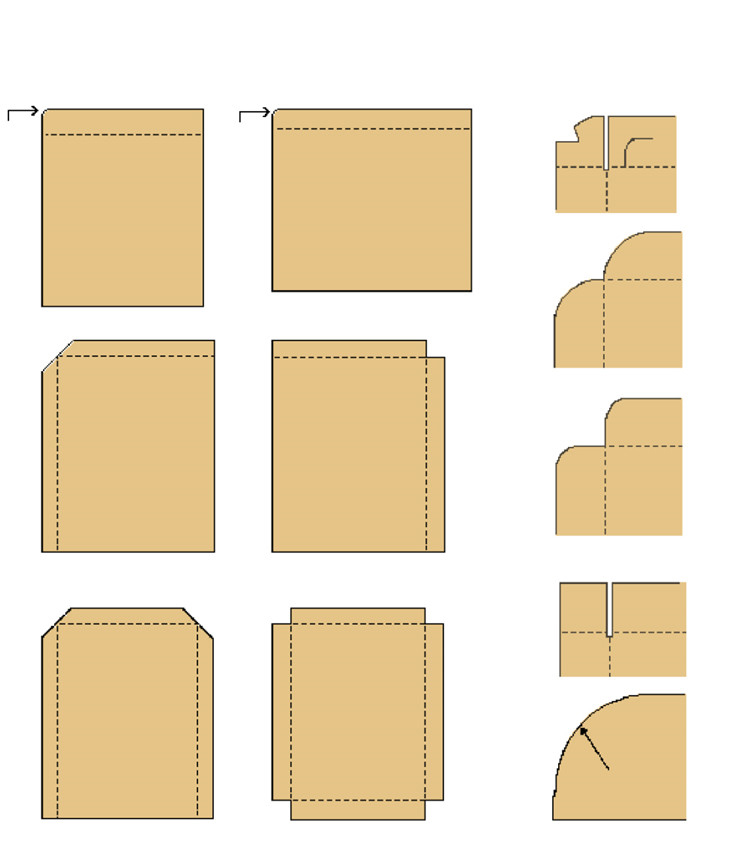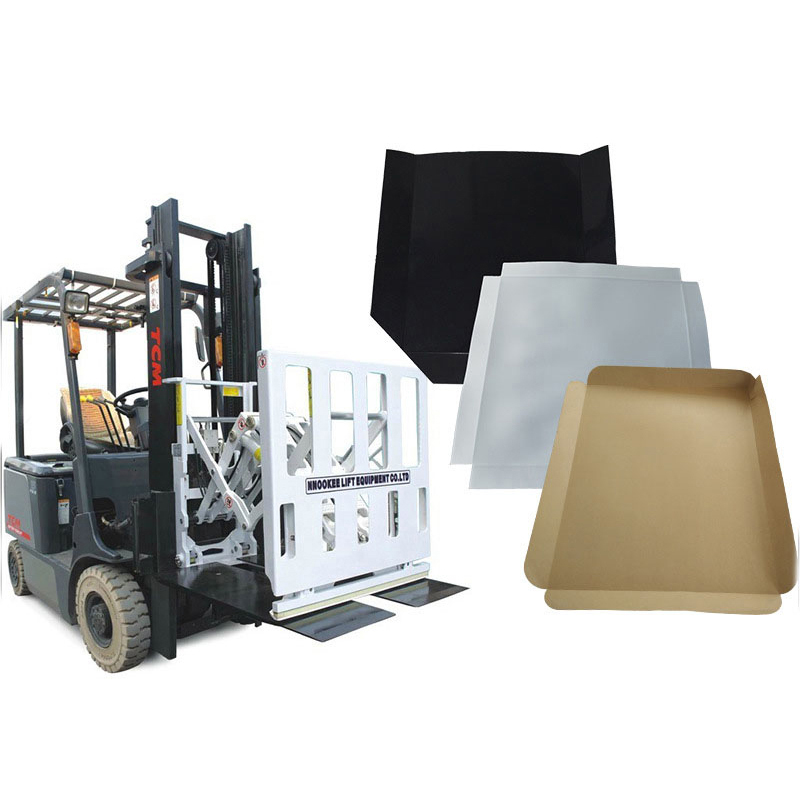Product profile
A kraft paper slip sheet is a thin, sturdy sheet made from heavy-duty kraft paper (often 2-5mm thick) used as a pallet-free base for transporting and storing goods. It serves as a lightweight, cost-effective alternative to wooden or plastic pallets, designed for use with forklift push-pull attachments.
Product application
1. Preparing the Load
- Place the slip sheet on a flat, stable surface.
- Stack products evenly on top (just like palletizing).
- Secure the load with stretch wrap, straps, or adhesive to prevent shifting.
2. Handling with a Forklift (Push-Pull Attachment Required)
- Step 1: The forklift operator positions the push-pull clamp over the extended lip (called the ”tab”).
- Step 2: The clamp grips the tab and pulls the slip sheet (with the load) onto the forklift’s platform.
- Step 3: To unload, the forklift pushes the slip sheet off onto the ground or rack.
3. Alternative Handling Methods
- Manual Handling (for lighter loads): Workers can slide the slip sheet using the tab.
- Pallet-Compatible Use: Can be placed on top of a pallet for extra stability.
Different type of corner and lip
Why the slip sheet is more popular than traditional pallet
1. Cost Efficiency
- Lower Material Cost: Slip sheets are made from thin, durable materials (like corrugated fiberboard or plastic), which are cheaper than wooden or plastic pallets.
- Reduced Shipping Costs: Since they are lightweight and flat, slip sheets save on freight weight and maximize container space (no pallet height or weight).
- No Pallet Return or Disposal Fees: Unlike pallets, slip sheets are often disposable or reusable without the need for reverse logistics.
2. Space Savings
- Compact Storage: Slip sheets take up minimal space compared to bulky pallets, allowing more efficient warehousing and shipping.
- Higher Load Capacity per Container: Without pallet height restrictions, more goods can fit in a truck or shipping container.
3. Sustainability & Eco-Friendliness
- Less Material Waste: Slip sheets use fewer raw materials than pallets, reducing environmental impact.
- Recyclable & Lightweight: Many are made from recyclable materials, lowering carbon footprint in transport.
4. Improved Handling Efficiency
- Faster Loading/Unloading: With push-pull attachments or forklift clamps, slip sheets allow quick handling without manual pallet handling.
- Automation-Friendly: Ideal for automated warehouses and robotic systems, as they require less space and can be easily integrated into conveyor systems.
5. Better Hygiene & Safety
- No Nails or Splinters: Unlike wooden pallets, slip sheets eliminate the risk of product damage or worker injuries from broken pallets.
- Sanitary Benefits: Plastic or coated slip sheets are easier to clean, making them ideal for food, pharmaceuticals, and cleanroom environments.
6. Customization & Flexibility
- Tailored Sizes & Materials: Slip sheets can be customized for different load types (e.g., anti-slip coatings for fragile goods).
- Compatible with Unit Loads: They work well with stretch wrap or strapping, securing loads just as effectively as pallets.
The advantage of slip sheet
1. Cost Savings
- Lower material cost – Made from affordable corrugated fiberboard, plastic, or laminated sheets.
- Reduced shipping expenses – Lighter weight = lower freight costs; no wasted space from pallet height.
- No pallet management – Eliminates pallet return, repair, or disposal fees.
2. Space & Storage Efficiency
- Ultra-thin design – Saves up to 90% storage space vs. bulky pallets.
- Maximizes container capacity – Fits more goods per truck/shipping container (no pallet footprint).
3. Sustainability Benefits
- Eco-friendly materials – Often recyclable or biodegradable (e.g., paperboard).
- Lower carbon footprint – Reduced transport weight and fewer raw materials used.
4. Logistics Optimization
- Faster handling – Push-pull forklift attachments enable quick loading/unloading.
- Automation-ready – Ideal for robotic warehouses and conveyor systems.
- Better load stability – Compatible with stretch wrap, straps, or interlocking designs.
5. Hygiene & Safety
- No splinters/nails – Safer for workers and products vs. wooden pallets.
- Cleanroom-friendly – Plastic or coated slip sheets meet food/pharma hygiene standards.
6. Customization & Versatility
- Tailored sizes/thicknesses – Adaptable to different loads (e.g., anti-slip coatings for glass).
- Multi-industry use – Ideal for retail, food/beverage, manufacturing, and export-heavy operations.
Here are the key features of paper slip sheets, which make them a popular choice in logistics and shipping:
1. Lightweight & Space-Saving
- Much lighter than wooden or plastic pallets, reducing shipping weight and costs.
- Saves storage space since they can be stacked flat when not in use.
2. Eco-Friendly & Sustainable
- Made from recyclable kraft paper or corrugated fiberboard.
- Biodegradable and compliant with green packaging regulations.
3. Cost-Effective Alternative to Pallets
- Lower material and handling costs compared to traditional pallets.
- Reduces freight expenses due to lighter weight.
4. High Load-Bearing Capacity
- Reinforced designs can support heavy loads (typically 1-2 tons).
- Some models have anti-slip coatings for better stability.
5. Compatible with Forklifts & Push-Pull Systems
- Works with specialized forklift attachments (push-pull or clamp mechanisms).
- Improves loading/unloading efficiency in automated warehouses.
6. Customizable Sizes & Thicknesses
- Can be tailored to fit different cargo dimensions (standard or custom sizes).
- Available in single or multi-layer constructions for varying strength needs.
7. Water-Resistant & Tear-Resistant Options
- Some are coated or laminated for moisture protection.
- High-quality kraft paper resists tearing during handling.
8. Improves Shipping Efficiency
- Enables palletless shipping, maximizing container space.
- Reduces labor costs with faster loading/unloading compared to pallets.
9. Safe for Food & Pharmaceutical Use
- Non-toxic and meets food-grade packaging standards (FDA, EU compliance).
10. Reduces Carbon Footprint
- Lower transportation emissions due to reduced weight.
- Supports sustainable supply chain initiatives.
Common Applications:
✔ Export packaging (replacing wooden pallets in international shipments)
✔ Automated warehouses (compatible with conveyor systems)
✔ Retail & grocery distribution (food-safe, lightweight)
✔ E-commerce fulfillment (space-saving for bulk orders)

